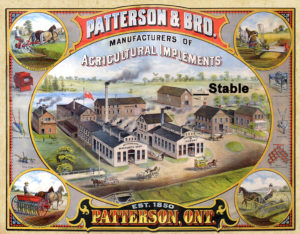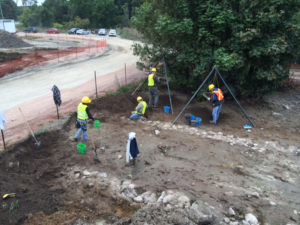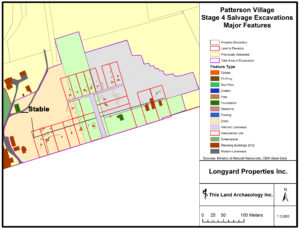Previously we discussed the findings of the village workshop and cobbler’s house, and this week we are pleased to share with you another fascinating discovery, the Patterson Village stable.
and this week we are pleased to share with you another fascinating discovery, the Patterson Village stable.
We know from historical records that the Patterson & Bro farm equipment manufactory was using horse-drawn wagons to haul its products to the railway station in what is today the town of Maple, bringing back raw materials such as iron for manufacturing its products. One wagon illustrated, perhaps filled with raw materials, is shown here in the lithograph of the manufactory.
In 2014, at the northwest end of our excavations we found a stone foundation which was 23 m long and 9 m wide. The southern end of the structure was underneath one of the laneways which was being used by workers installing services and grading the land for DG Group’s new subdivision. We had to close this laneway for two days and remove the fill from it in order to fully excavate this foundation.
We discovered that the foundation for the building was originally 13 m long and 9 m wide and had been constructed with dry-laid field stones. There was a 10 m addition to this foundation, with the stone work being mortared in place. We uncovered very few artifacts in this structure, which made me wonder, initially, whether it might have been a building to store farm equipment before it was shipped.
I mentioned this building to Ruth Redelmeier, who as I’ve have shared in earlier blogs, has spent more than two decades researching the Patterson family, the manufactory, and Patterson Village. Before long, I heard from Ruth that she believed that we had discovered the village stable used to house the teams of horses used to transport product and raw materials.
This stable is clearly visible in the lithograph from the 1880s and its location in that illustration is almost identical to the location of the foundation we revealed.

This discovery is important in that it correlates our excavated information reflected in the lithograph. It also demonstrates the difficulty of determining the function of structures we excavate since there are often few artifacts to assist in determining possible uses of the structure.
Another great job done. Many thanks to my team, and to Ruth Redelmeier. If you are curious about Patterson Village, you will love perusing the beautiful pages of my book, The Archaeology of Patterson Village which is available for purchase in the I C bookstore.
Thanks kindly,
Bill Finlayson
William D. Finlayson, Midland, Ontario
Ontario’s Leading and Senior-Most Archaeologist and Author